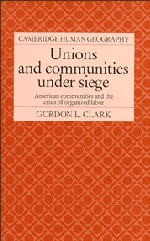Book contents
- Frontmatter
- Contents
- List of tables
- Preface
- Acknowledgments
- PART I ECONOMY AND COMMUNITY
- PART II DRAMA OF ECONOMIC RESTRUCTURING
- PART III UNION PERFORMANCE IN REPRESENTATION ELECTIONS
- PART IV REGULATING LOCAL LABOR–MANAGEMENT RELATIONS
- 8 Integrity of the National Labor Relations Board
- 9 Options for restructuring the US economy
- PART V PROSPECTS FOR ORGANIZED LABOR
- Appendix 1 Variables and data sources
- Appendix 2 Cases cited
- Notes
- Bibliography
- Name index
- Subject index
9 - Options for restructuring the US economy
Published online by Cambridge University Press: 13 October 2009
- Frontmatter
- Contents
- List of tables
- Preface
- Acknowledgments
- PART I ECONOMY AND COMMUNITY
- PART II DRAMA OF ECONOMIC RESTRUCTURING
- PART III UNION PERFORMANCE IN REPRESENTATION ELECTIONS
- PART IV REGULATING LOCAL LABOR–MANAGEMENT RELATIONS
- 8 Integrity of the National Labor Relations Board
- 9 Options for restructuring the US economy
- PART V PROSPECTS FOR ORGANIZED LABOR
- Appendix 1 Variables and data sources
- Appendix 2 Cases cited
- Notes
- Bibliography
- Name index
- Subject index
Summary
In the first half of this decade, the United States economy went through a remarkable cycle of fortune. From the severest recession since the Great Depression, the national economy has prospered to the point where some believe that its success threatens the integrity of the whole economy. While the economy is not quite at full employment, domestic macroeconomic indicators appear robust when compared to European conditions. Even so, the economic recovery has been very uneven, sectorally and spatially. Restructuring and deindustrialization have accompanied the recovery so that even as the economy has added new jobs, other union jobs have been lost. The new jobs created are quite different, by skill, sector, union representation, and location, to the jobs lost. There appears to be a new economic geography, markedly different than the post-war era.
In terms of labor policy, there remain important issues to be considered in how restructuring should be designed and accommodated. One fundamental issue has to do with how local labor relations might be modified so that American industries, particularly heavy manufacturing industries, remain economically competitive in the face of foreign competition. This is not simply a question of economic efficiency, or of policy inventiveness. While many citizens, whether labor or management, Democratic or Republican, secular or nonsecular, desire economic success, there are just and unjust ways of ensuring future prosperity. Current policy options for redesigning local labor relations have significant equity dimensions which may be as important as their economic consequences.
- Type
- Chapter
- Information
- Unions and Communities under SiegeAmerican Communities and the Crisis of Organized Labor, pp. 171 - 190Publisher: Cambridge University PressPrint publication year: 1989



